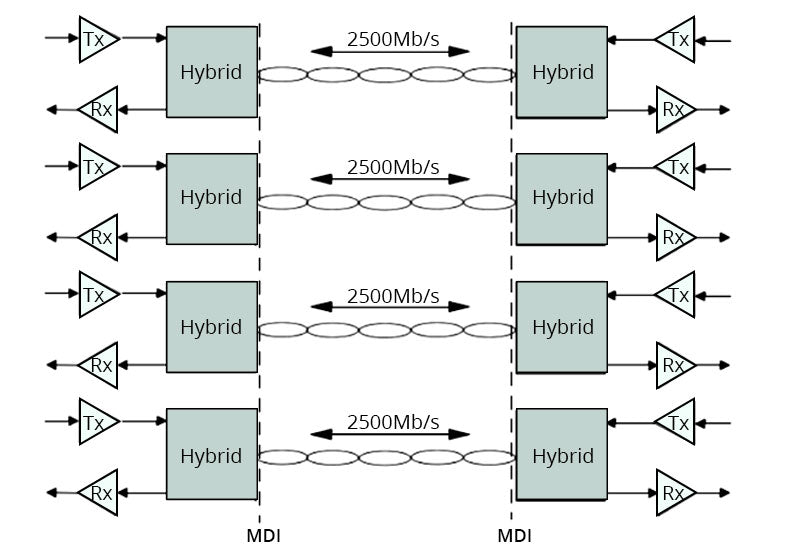Everything You Should Know About 10GBASE-T SFP+ Transceiver
Everything You Should Know About 10GBASE-T SFP+ Transceiver

10GBASE-T Explained
In 1999, 1000BASE-T was defined by IEEE 802.3ab, which is the Gigabit Ethernet standard over copper wiring cable. 1000BASE-T enables the max transmission distance of 100 meters over unshielded twisted pair (UTP) Cat5 cable or better (including Cat5e and Cat6). With the arrival of 1000BASE-T, Gigabit Ethernet became a desktop technology and has been a standard configuration for the personal computer.
With the growing popularity of 1000BASE-T cabling, then people focused on a higher-speed Ethernet, 10 Gigabit Ethernet. In 2006, IEEE 802.3an defined the 10 Gigabit Ethernet standard of 10GBASE-T, which support 10 Gbit/s speed over unshielded twisted pair (UTP) or shielded twisted pair (STP) cable. The max transmission distance also can be up to 100 meters. To reach a full distance of 100m,10GBASE-T requires Cat6A cables. For Cat6 cable, 10GBASE-T supports a max transmission distance of 55 meters.
10GBASE-T SFP+ Transceiver Introduction
10GBASE-T SFP+ transceiver (also known as 10GBASE-T copper SFP+ transceiver ) has an RJ45 connector, using twisted pair Cat6A cable or better, to interconnect the RJ45 port of 10GBASE-T switch or server. The working diagram of 10GBASE-T SFP+ is shown below.

Modulation Mode of 10GBASE-T Transceiver
10GBASE-T still adopted the 1000BASE-T transmission mode, using four differential pairs for simultaneous bidirectional and full-duplex transmission, but the total transmission rate is as high as 10Gbps. In principle, to reach a transmission speed of 10 Gbit/s over four pairs of wires, each pair of wire need to realize a speed of 2500Mb/s, as shown in the below figure.

However, there is no copper cable that supports 2.5Gbps. Each copper wire of Cat6A can only support 500MHz bandwidth. To reach 10GBASE-T, IEEE intelligently designed a Tomlinson-Harashima Precoded (THP) version of pulse-amplitude modulation with 16 discrete levels (PAM-16) as the signal modulation mode. Each modulation symbol carries 3.125 data bytes to realize a modulation rate of 800MBd. So that the 10GBASE-T SFP+ transceiver can transmit 10 Gbit/s speed at four copper pairs.
800 Mbaud x 3.125 bit/dim x 4 pairs = 10 Gbit/s
Backward Compatibility of 10GBASE-T SFP+
Backward Compatibility is the most significant characteristic of 10GBASE-T SFP+ transceiver. By using the auto-negotiate function, the 10GBASE-T transceiver can be backward compatible with 1000BASE-T and 100BASE-T, so the 10GBASE-T cable infrastructure can also be used for 1000BASE-T/100BASE-T, which means it allowing a gradual upgrade from the existing 1000BASE-T/100BASE-T cabling infrastructure to choose which speed used instead of upgrading all network switches or servers to 10GbE at once.
100BASE-T vs 1000BASE-T vs 10GBASE-T
The major differences between 10GBASE-T, 1000BASE-T, and 100BASE-T are concluded in the following table.
|
100BASE-T |
1000BASE-T |
10GBASE-T |
|
|
Speed |
100Mbps |
1000Mbps |
10Gbps |
|
Modulation |
PAM-3 |
PAM-5 |
PAM-16 |
|
Wire Pairs Required |
2-Pair |
4-Pair |
4-Pair |
|
Symbol Rate Per Lane |
125Mbaud |
125Mbaud |
800Mbaud |
|
Bandwidth |
31.25 |
62.5 |
400 |
|
Max Distance |
100m |
100m |
100m |
|
Cable Type |
Cat5 or better |
Cat5 or better |
Cat6A or better |
|
Cable Rating |
100MHz |
100MHz |
500MHz |
|
Encoding |
MLT-3 |
4D trellis-coded modulation (TCM) |
Tomlinson-Harashima precoding (THP) DSQ-128 |
Benefits of 10GBASE-T
- Backward Compatible. 10GBASE-T is compatible with its previous version of 1000BASE-T and 100BASE-T by using the auto-negotiate function, which is helpful for gradually upgrading from the existing 1000BASE-T or 100BASE-T cabling structure to 10G connections.
- Cost-effective. There are two transmission media for 10 Gigabit Ethernet, optical fiber, and copper. Compared to optical fiber cables, copper cable based 10GBASE-T SFP+ is more cost-effective.
- Low Latency. Compared with 1000BASE-T, 10GBASE-T improve the latency from 12μs to 2μs.
Can 10GBASE-T SFP+ work on Cat5e/Cat6/Cat6A/Cat7 Cable?
- Cat6A: The best cabling option for 10GBASE-T SFP+. Connecting with 10GBASE-T SFP+ transceivers, Cat6A supports a link length up to a full distance of 100 meters. The cost of the Cat6A cable is also reasonable.
- Cat7 Cable: The arrival of Cat7 is early than Cat6/6A, even earlier than the launch of the 10GBASE-T standard. Unfortunately, Cat7 is not recognized by TIA. Cat7 supports 600MHz bandwidth, which is higher than Cat6A. It also enables 10GBASE-T SFP+ transceivers at a transmission distance of 100 meters. Cat7 cable is fully shielded, each individual pair foil shielded, which means the wire diameter Cat7 is much larger than Cat6A. So it will be difficult to terminate and takes up more space. Moreover, Cat7 cables don’t use the RJ45 connectors. They use GG45 or TERA connectors. Since most devices use RJ45 connectors, Cat7 cables don’t have ideal compatibility. Lastly, the price of Cat7 is higher than Cat6A, so it is not recommended.
- Cat6 Cable: Cat6 supports a speed of 10Gbps, however, the transmission distance is limited to 55 meters, shorter than Cat6A.
- Cat5A Cable: 10GBASE-T SFP+ can't properly work over Cat5A at a speed of 10Gbps. If you have to connect Cat5A with the 10GBASE-T SFP+ Rj45 transceiver, the transceiver may auto-negotiate to 1000Mbps.
Conclusion
The above article has mainly introduced what is 10GBASE-T and 10GBASE-T SFP+ transceivers, the advantages of 10GBASE-T, the differences between 10GBASE-T, and its backward compatible 100BASE-T/1000BASE-T standard, and the ideal copper cabling solutions of 10GBASE-T SFP+. Hope it will be helpful for getting a better understanding of 10GBASE-T.
QSFPTEK provides cost-effective and high-performance 10GBASE-T SFP+ transceivers and cat6A copper cables, supporting links up to 30 meters and 80 meters over Cat6A at a low power consumption of less than 2.5W and the BER ( Bit Error Rate) is below 10^-12. They are widely compatible with almost all OEM’s 10GBASE-T switches, NICs, and servers, such as Cisco, Juniper, Arista, Intel, HPE, etc. Welcome to consult via sales@qsfptek.com.














































































































